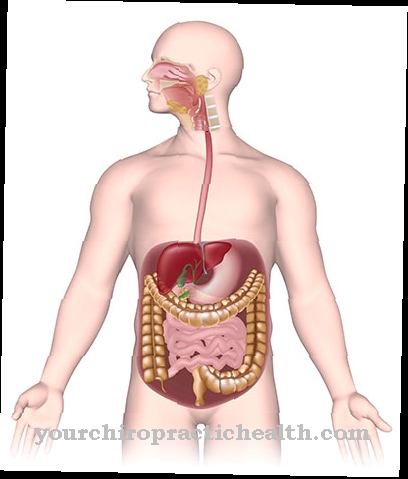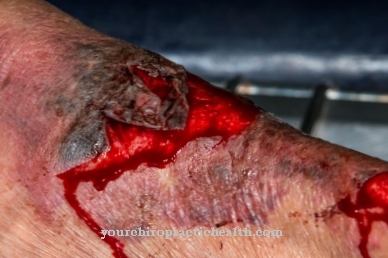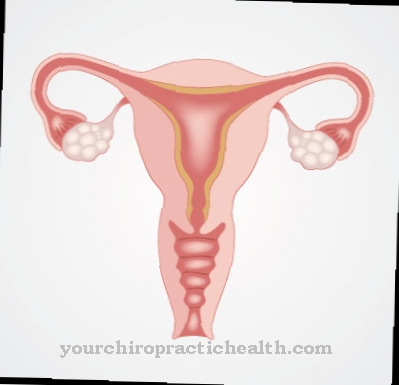Of the Heel spur is a stubborn and in the majority of cases stressful disease, which, like hallux valgus (bunion), contributes to more or less severe limitations in walking and which affects more and more people. Because of the painfulness and impairment of the functionality of the foot, the heel spur forces the patient to increasingly restrict walking.
What is heel spur?

© Artemida-psy - stock.adobe.com
Of the Calcaneus spur, often known colloquially as heel spur and better known by this name, is based on abnormal growths of bone substance.
A heel spur is an irregular, deformed increase in bone tissue that can be characterized as a so-called bone outgrowth.
The heel spur manifests itself on the foot, on the calcaneus. There is the origin for a muscle of the calcaneus. The heel spur is known in medical diagnostics as plantar heel spur and as Haglund heel spur or Haglund exostosis.
causes
Various factors are named as the cause for the formation of heel spurs. Basically, it can be mechanical triggers that consist of the constant exertion of pressure and tensile force on the heel bone. Poor posture or misalignment of the foot skeleton and unsuitable footwear are responsible for these overloads, which favor a heel spur.
The external causes, which can often be influenced by those affected themselves, are excessive body weight and in particular extreme obesity, misalignments on the feet such as flat, arched or splayfoot and the constant exercise of very difficult physical activities. In addition, the development of heel spurs can be promoted by the fact that patients wear poorly fitting or pressure-exerting footwear and exercise excessively without being adequately trained beforehand.
Another possible trigger for heel spur are genetic predispositions. The cause of the Haglund exostosis as a heel spur is a mechanical irritation of the Achilles tendon attachment by the heel-side edge of the shoe.
Symptoms, ailments & signs
Typical symptoms of heel spurs are pain at the tendon attachments. The main pain here is sharp pains on the soles of the feet. This pain usually occurs in the early morning, when the first steps out of bed take place. But even after the feet have been resting for a long time, severe stabbing pain occurs again.
The heel spur usually forms over the course of several weeks or even months and is therefore slowly becoming apparent with increasingly severe discomfort and pain. Only after a while, when it is more pronounced, is it palpable or visible to the outside of the affected area with the naked eye. A bulge is perceived at the point where the heel strikes.
The bulge is hard and gives a little under pressure, but it is painful. Increasingly severe pain is also felt when walking and walking normally. In the upper heel spur, however, there is pressure pain in the area of the Achilles tendon. Stress pain when walking can also occur here. In addition, there is occasional reddening of the skin in the affected areas.
The heel spur is often caused by excessive strain or improper strain, and incorrect footwear can also be the cause. It is one of the very common sports injuries and often occurs in runners, boxers and footballers. It is often associated with plantar fasciitis, in which the tendon running down the foot is overloaded. Overloading the Achilles tendon can also lead to a heel spur, and vice versa.
In rarer cases, the heel spur also occurs on the back of the heel and not on the tread surface. Typically, a calcaneal spur registers with a longer lead time, so that it can well happen that the symptoms are sometimes more and sometimes less pronounced when they occur. The symptoms often go away again in this early phase.
course
A heel spur causes excessive stress on the tendon of the sole of the foot, which is known as the plantar fascia, and initially minimal tears begin. The irritation of the periosteum and other tissue parts forms small inflammation foci, which are expressed in pain in the lower heel region of the heel spur.
The heel spur is formed through the deposition of calcium substances for the repair of the tears. This always runs right next to the tendon cord. If the foot is subjected to excessive tensile stress at the base of the foot, which is typical in the case of a malalignment known as a flat arch, then this can lead to tendon ossification if a lower heel spur is present.
Complications
If a heel spur is not treated medically for a long time, an increase in inflammation of the surrounding soft tissue is to be feared. The complications of heel spur are often exacerbated by intense irritation. Sometimes this can even trigger a fatigue fracture of the heel bone because the stress on the bone is increased and there is no longer any tension on the tendon plate.
These complaints make a later operation inevitable due to the non-treatment. After an operation, it cannot be ruled out that the condition manifests itself through wound healing disorders, infections or problematic scars. In addition, nerve injuries with local numbness can occur.
Furthermore, complications in the form of a thrombosis or pulmonary embolism can occur despite treatment. In rare cases, a treated heel spur can also lead to a bone infection (osteomyelitis). Regardless of whether the heel spur is treated conservatively with drugs or surgically, there is a risk that the complications will recur and the pain will recur.
Early treatment of the calcaneal spur is also important to avoid risking long-term damage. Otherwise, these could cause changes in the static footprint or develop a chronic course of pain.
When should you go to the doctor?
If there is painful swelling on the foot or heel, a doctor should be consulted promptly. A noticeable heel spur is best examined and treated by a specialist. If inflammation occurs on the foot, medical advice is also required. Failure to do so may result in a fatigue fracture of the calcaneus that will require hospital treatment. Chronic pain and symptoms of circulatory disorders should also be clarified by a doctor.
If there are serious complications such as thrombosis or pulmonary embolism, an emergency doctor must be called. First aiders must provide first aid and check the patient's pulse and breathing. In most cases, however, a heel spur is unproblematic. However, a visit to the doctor is necessary in order to rule out secondary symptoms and to remove the ossification if necessary.
In addition to the family doctor, the orthopedist or a chiropractor can be visited, depending on any accompanying symptoms and the previous course of the disease. If a misalignment in the feet is the cause, it must be treated by a foot surgeon or orthopedic surgeon.
Doctors & therapists in your area
Treatment & Therapy
The heel spur is a deformity that does not always result in painful complaints. If the heel spur is not too badly impaired, therapy is usually not carried out. Different types of therapy can only be implemented when those affected can barely walk and pain occurs.
These initially consist of the initially conservative treatments and any surgical measures that may be required. In some cases, the treatment of heel spurs is already successful and the pain is reduced when the affected foot areas are relieved. In the case of a plantar or lower heel spur, orthopedic aids such as a so-called heel cushion with a perforated insert are recommended.
In addition, perforated inlays complement the treatment. If it is a haglund exostosis as heel spur, shoes made of soft materials and lower back edges than the heel spur are advantageous. Further forms of therapy for heel spurs are heat and cold as well as ultrasound treatments.
The application of shock wave technology is also effective in the heel spur. On the side, pain reliever and anti-inflammatory ointments are often prescribed.
During a surgical procedure, the heel spur is gradually removed by abrasion and a certain part of the tendon cord is removed.
Outlook & forecast
Provided that the skeletal system has not been damaged, the heel spur has a good prognosis when medical care is used. A regression of the complaints without active countermeasures is not to be expected. Since the cause is an inflammatory process, it must be cured by administering medication.
Spontaneous healing is not to be expected. If independent measures are taken to support the prescribed medicine, the symptoms are reduced and the healing process is shortened. Wearing healthy shoes and regular stretching exercises improve wellbeing and promote recovery.
Heel spur can reappear in the course of life despite the good prognosis. If the disease recurs, the chances of recovery remain favorable. The renewed formation of the heel spur depends on factors that can be influenced by the person concerned.
Overexertion and obesity should be avoided so that healing takes place in the long term. In addition, wearing shoes with high heels or the wrong size should be avoided. If the tips for self-help are followed, there is a good chance of a permanent cure.
If the skeletal system has already developed permanent impairments due to the outgrowth of bones, the prospect of complete freedom from symptoms deteriorates. Depending on the extent of the damage, there may be lifelong restrictions or mobility problems.
prevention
In order to avoid the formation of a heel spur, it is advisable to avoid tight, pressing and rubbing shoes. If the feet are misaligned, appropriate orthopedic measures ensure that prevention against heel spurs can be guaranteed. A reduction in body weight, the avoidance of overloading and overstressing of the feet, even through long standing, is also considered a prophylaxis against heel spurs.
Aftercare
Doctors advise avoiding surgery initially as it can cause persistent pain. Therefore, the best aftercare is prevention. This usually falls within the patient's area of responsibility. The attending physician provides information on suitable measures. In addition, physiotherapy can be arranged. If the symptoms are due to inflammation, medication can also help.
Basically, those affected should protect the tendons on the soles of their feet. You can achieve this by choosing comfortable footwear. In no case should it be too tight. Sufficient stretching is important before any sporting activity. Brief posture exercises can provide relief. Strengthening the foot muscles through long walks on uneven terrain is advisable.
Shoes can be cushioned with the help of insoles. This takes the strain off the feet in everyday life. Furthermore, being overweight puts a strain on the heel - with every step. Diet can help and significantly reduce the symptoms.
If the typical signs of the calcaneal spur are permanent, scheduled checks are necessary. In addition to a superficial examination, the doctor usually has an X-ray taken. The degree of ossification is thus clearly visible. The progress is clearly documented. A surgical procedure can also be discussed in this way.
You can do that yourself
Usually a pronounced heel spur with stabbing pain occurs every morning when you take your first steps after getting up. A less pronounced heel spur, on the other hand, usually does not cause any discomfort, so that it is usually not noticed. Since many different causes can trigger the development of a lower or an upper heel spur, it is advisable to investigate possible reasons as soon as the first signs appear.
This can be, for example, poorly fitting footwear, constant incorrect stress in sport or simply overstressing the foot as a result of extreme excess weight. In many cases, other footwear that is better adapted to the anatomy of the foot helps as a self-help measure.
In the case of athletes who have problems with a heel spur, it is advisable not only to think about changing shoes, but to seek advice from an experienced physiotherapist about the shoes and certain movement sequences in order to practice another less stressful movement sequence.
If the heel spur is mainly caused by an acquired or congenital foot deformity, custom-made insoles usually help, they help to gradually reduce the incorrect load on the foot, which can curb the pain-causing inflammation on the foot tendons. It is advisable to have the insoles made by an experienced orthopedic shoemaker. The insoles can be permanently installed or loosely inserted so that they can also be used for other shoes.


.jpg)
.jpg)

.jpg)






.jpg)



.jpg)










.jpg)
